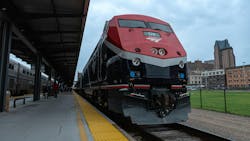Editor's Notebook: Amtrak’s expanding, but can funding keep up?
Amtrak has been making headlines this year—and not always for the right reasons. From renewed calls for privatization, to the abrupt departure of its CEO and major project shifts announced by the Federal Railroad Administration (FRA), the company is juggling a complex landscape with competing interests. However, these challenges shouldn’t overshadow Amtrak’s tangible progress.
For starters, Amtrak set a new ridership record in fiscal year (FY) 2024, reaching 32.8 million passengers—a 14 percent increase over FY23. That momentum is carrying into 2025 as the company launches new services and expanded routes. At the same time, maintenance investments addressing critical infrastructure are improving service reliability across the Northeast Corridor (NEC) and national network.
Increased funding is also improving reliability and supporting growing ridership. In FY24, Amtrak reported $3.6 billion in operating revenue, up seven percent from the previous year. The 2025 Infrastructure Report Card from the American Society of Civil Engineers (ASCE) noted that Amtrak’s FY23 revenue reached 97 percent of pre-COVID-19 levels—a 20 percent jump from FY22. These revenue increases, coupled with $22 billion in dedicated funding from the Infrastructure Investment and Jobs Act (IIJA), have fueled overdue infrastructure upgrades. The construction contract was awarded for the Sawtooth Bridges replacement; the Portal North Bridge Project reached about 75 percent completion; and work began at the King Street Yard maintenance facility in Seattle.
Amtrak is also focused on expansion. In May 2024, it launched the Borealis route between Chicago and Minneapolis, which reached 100,000 riders in under six months. Coming this summer, the new Mardi Gras Service will begin revenue service between New Orleans, La., and Mobile, Ala. The Virginia Passenger Rail Authority’s New River Valley Rail Project, which broke ground earlier this year, will extend the Amtrak Virginia service to Christiansburg in 2027. These efforts, along with several other route enhancements, support Amtrak’s goal to double ridership to 66 million by 2040.
Amtrak’s vision for expanded service is ambitious, but ambition alone won’t get the job done. Serious investments that build upon the IIJA will be needed. According to ASCE’s report card, only 40 percent of the $175 billion needed for NEC improvements is currently funded. Of the 171 projects expected to start by 2028, only 21 have full funding. Similarly, Amtrak’s nationwide service expansion plan, which includes 39 new and 25 expanded routes, is expected to cost $75 billion over 15 years.
Amtrak is at a pivotal moment. With strong ridership growth and increased public interest in passenger rail, the momentum is real. But in order to meet the moment, there will need to be stable, long-term federal investment paired with a regulatory environment that encourages private investment and supports innovative financing options. Passenger rail is gaining ground. The question is: Will we keep building on it?
About the Author
Megan Perrero
Editor in Chief
Megan Perrero is a national award-winning B2B journalist and lover of all things transit. Currently, she is the Editor in Chief of Mass Transit magazine, where she develops and leads a multi-channel editorial strategy while reporting on the North American public transit industry.
Prior to her position with Mass Transit, Perrero was the senior communications and external relations specialist for the Shared-Use Mobility Center, where she was responsible for helping develop internal/external communications, plan the National Shared Mobility Summit and manage brand strategy and marketing campaigns.
Perrero serves as the board secretary for Latinos In Transit and is a member of the American Public Transportation Association Marketing and Communications Committee. She holds a bachelor’s degree in multimedia journalism with a concentration in magazine writing and a minor in public relations from Columbia College Chicago.

